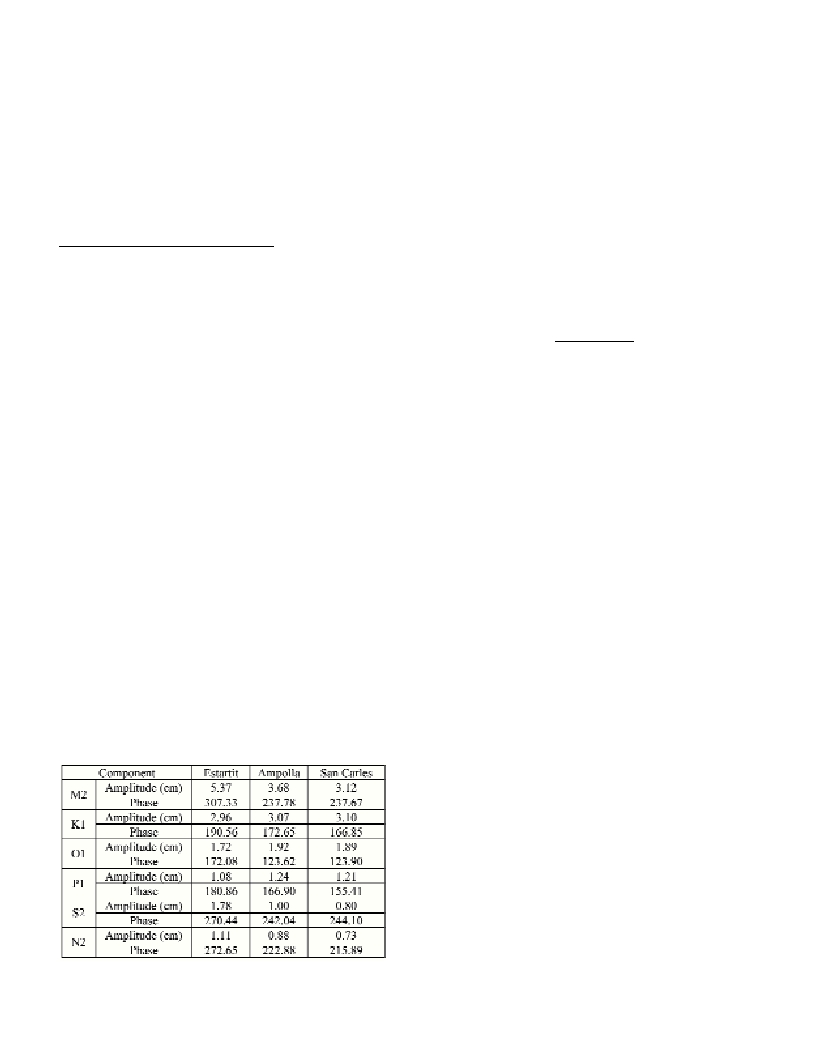Rapp. Comm. int. Mer Médit., 37,2004
117
ASTRONOMICAL AND METEOROLOGICAL TIDE DESCRIPTION IN THE CATALAN COAST.
López J.
1*
, Espino M.
1
, Martínez-Benjamín J.J.
2
, Sánchez-Arcilla A.
1
1
Laboratori d’Enginyeria Marítima, Universitat Politècnica de Catalunya, Campus Nord, Mòdul D1, c/ Jordi Girona 1-3,
08034 Barcelona, Spain - * jaime.lopez-marco@upc.es
2
Departamento de Física Aplicada. , Universitat Politècnica de Catalunya, Campus Nord, Mòdul D1, c/ Jordi Girona 1-3,
08034 Barcelona, Spain
Abstract
Due to small tidal induced sea level variations [1], the Mediterranean Sea is an attractive site to calibrate and validate altimeter data from
the TOPEX/POSEIDON and JASON satellites. Hence, the need to determine accurate sea level variations and to better estimate different
components that contribute to sea level variability. The objectives of this study are therefore, to associate sea level variations with
astronomical tide, to determine and to quantify the atmospheric forcing that cause these sea level variations.
Keywords: sea-level, Mediterranean, tides.
Introduction
Time series of sea level in the Catalan Sea, provided by the
l’Estartit harbour tide-gauge, operational since 1990, and the XIOM
net tide-gauges set in la Ampolla and San Carles de la Ràpita harbours
both operational since 1997, was used. From these time series the
study of sea level variation was divided in several phases.
The first phase consists in following the evolution of the mean
daily, monthly and annual sea level values. Second phase includes the
harmonic analysis of the tide-gauges data to determine the harmonic
components of the astronomical tide. After obtaining a tide prediction
and a meteorological residual, an analysis to compare residual with
the atmospheric pressure effect, known as inverted barometer effect,
was made. In the dates that, the previous effect, did not adjust to the
residual, a wind analysis will take place, in order to determine the
cause of this non-pressure residual.
Mean daily, monthly and annual value analysis
From these analyses, there are two interesting conclusions to
comment. An annual cycle of sea level with maximum mean sea level
values in autumn (October and November) and the minimum mean
values in winter (February and March). This annual cycle can be
explained by the steric component, ocean dynamics and upper layer
heat variability as commented in [2].
Moreover, we can also observe a small ascent of the annual mean
sea level in the Catalan Coast through the years, although we can find
two abnormally high mean sea levels for the years 1996 and 1997.
Tidal harmonic components analysis
From a least-squares fit between the time series and the frequencies
associated to the astronomical movements, done with the Foreman
method [3] and with the T_TIDE program [4], the amplitudes and
phases of the harmonic tidal constants have been found and
quantified. The same has been done with 95% confidence interval for
both amplitude and phases of the harmonic tidal components. The
most important harmonic components found for the Catalan Coast
are, in decreasing importance order: M2, K1, O1, P1, S2 and N2
(Table1). The amplitudes associated to each one of the previous
components are smaller than 5 cm. We can also find large period
components with similar amplitude order than M2 component.
The components with semidiurnal frequencies have an interesting
behaviour. The amplitudes associated to these components increase
their values from South to North along the Catalan Coast. However
the diurnal components do not present a clear behaviour and remain
near constant values along the Catalan Coast. This behaviour is also
observed in other tide-gauges [5]. This change in the amplitudes of the
semidiurnal harmonic components produces a change in the Form
Factor (F) value,
which increases its value southward.
Once we have the amplitudes and phases of the harmonic
components, we can predict the tide. This prediction fits quite well to
the real measured sea level time series. But there is a difference
between them, this difference is known as meteorological tide, and
can be caused by atmospheric forcing like atmospheric pressure or
wind stress.
Inverted Barometer Effect and wind stress analysis
With the atmospheric pressure data obtained from the
meteorological stations placed very close to the tide-gauges, the
inverted barometer effect [6] has been calculated to obtain the relation
with the meteorological residual. There is a clear relation and a good
fit between both, meteorological residual and inverted barometer
effect, nevertheless there are still some periods in which the difference
between the two parameters are still important.
To determine the cause of these differences, it is necessary to
analyse the wind systems of those periods to obtain the main
direction, mean velocity and hence, the wind stress in each period.
The goal of this study is to calculate the relation between the wind
stress and the remaining meteorological residual. All this work will
allow us to know the effect of the distinct storms in the Catalan Coast
and to be able to forecast with great accuracy sea level changes in this
part of the Mediterranean Sea.
References
[1]Tsimplis, N.T., Proctor, R. and Flather, R.A., 1995. A two-dimensional
tidal model for the Mediterranean Sea. J. Geophys. Res.,100(C8) 16: 223-
16,239.
[2]Bouzinac, C. J. Font, and J. Johannessen, 2003. Annual cycles of sea
level and sea surface temperature in the western Mediterranean Sea. J.
Geophys. Res.,108(C3): 3059.
[3]Foreman M. G.G., 1979. Manual for tidal heights analysis and
prediction, Pacific Marine science report 77-10, Institute of Ocean
Sciencies, Patricia Bay, Victoria, B.C.
[4]Pawlowicz, R., B. Beardsley, and S. Lentz, 2002. “Classical Tidal
“Harmonic Analysis Including Error Estimates in MATLAB using
T_TIDE”, Computers and Geosciences, 28: 929-937.
[5]Annual Reports of the Spanish tides from Ente Público Puertos del
Estado. www.puertos.es.
[6]Le Traon, P-Y. and Gauzelin, P., 1997. Response of the Mediterranean
mean sea level to atmospheric pressure forcing. J. Geophys. Res.,102(C1):
973-984.
)
2
(
)
2
(
)
1
(
)
1
(
S
A
M
A
O
A
K
A
F
+
+
=

